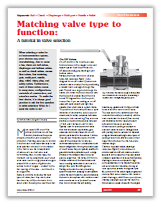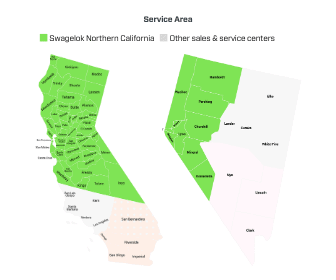Choosing the Right Swagelok Valve for the Job: Part 2
by Jeff Hopkins, on 11/13/12 10:46 AM
Some valves are designed to provide good control of flow or direction, or guard against overpressure

In Part 1 of our series on valve selection, we looked at the types of valves best suited for the basic on-off function. But valves can do a lot more. In this post we will look at flow control, direction control, and overpressure protection.
FLOW CONTROL
When you want to set the handle for the right flow and have it stay there, the most common choices are needle valves, fine metering valves and plug valves. Their fine threads allow for precise flow control, and some designs give you leak-tight shut off capability. For the most precise control, choose a type of needle valve called a fine-metering valve. Be aware that some models are not designed to shut off.
- Quarter-turn plug valves are economical utility valves. They work by using a cylindrical plug with an orifice to permit flow. As the name indicates, a quarter-turn of the handle opens the valve all the way. They are commonly used for low-pressure throttling applications.
- A closely related design is the rising plug valve. It uses a tapered plug that lowers into the orifice to control flow. In that sense, it is similar to a needle valve. Rising plug valves are not as effective at providing fine gradations of flow, but they are roddable, which makes them a good choice if the valve gets clogged.
DIRECTION CONTROL
In some circumstances, you need to control the direction of fluid flow as well as the rate.
- Check valves make sure that the fluid goes only in one direction. Typically, the upstream pressure compresses a spring inside the valve to push open a poppet to allow flow. If the downstream pressure rises, it forces the poppet back into its seat and cuts off any reverse flow. Some check valves are adjustable, so you can set them to a more specific cracking pressure.
- Flow can also be controlled with some ball valves and diaphragm valves that have multiple ports. Fluid enters through a single inlet, but the valves have multiple outlets. Turning the handle selects which port the fluid will flow out of. Not all multi-port valves have shut-off positions.
OVERPRESSURE PROTECTION
Valves don't regulate pressure, but some designs do prevent the buildup of system pressure beyond a certain point.
- One type is the relief valve. Some relief valves contain a vent that opens to the atmosphere when the system pressure exceeds a point that you've selected. A spring-loaded poppet allows fluid to be released, then closes up when the pressure drops back below the pre-set point. These are known as proportional relief valves.
- A variation on the design is the safety valve. It is designed to open quickly and release large amounts of fluid.
- Rupture discs also vent to the atmosphere. A metal diaphragm bursts when the pressure goes beyond a point set by the manufacturer. They are used mainly on sample cylinders to guard against over-pressurization, such as when temperature rises. Once the disc bursts, it must be replaced.
- Excess flow valves stop uncontrolled release of fluids if the line ruptures downstream. Under normal conditions, a spring holds a poppet open. When there's excess flow downstream, the poppet trips and stops almost all fluid flow. When the system is fixed, the poppet returns to the open position.
Additional resources



/Digital%20montage%20(1).jpg?width=1920&name=Digital%20montage%20(1).jpg)


